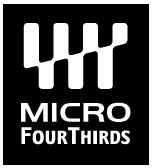Pros and Cons of Four Thirds & Micro Four Thirds Cameras
The Future of Photography
The Four Thirds camera systems are an attempt to revolutionize digital cameras forever. However, they are both largely a system of compromise. If you are thinking of investing in either of these systems, you need to know the facts. What follows is a list of pros and cons for each.
The Pros
General Advantages
- Smaller form factor. Compared to conventional DSLR cameras, a Four Thirds camera is much smaller and lighter. This makes them portable, light and easy to travel with.
- A 2x crop factor. The sensor is small and has a greater crop factor than that of a DSLR from Nikon, Canon, Sony or Pentax. This means that a 200mm telephoto lens has the 35mm equivalent range of 400mm, instead of 300mm on a regular DSLR.
- Smaller, lighter lenses. The 2x crop factor, discussed above, means that Four Thirds lenses can be smaller, and therefore lighter, and still have a zoom range equivalent to that of traditional cameras.
- Lens quality. Lenses are made by the likes of Olympus and Leica. Both of these manufacturers have a reputation of quality workmanship, and they produce lenses that are hard to match.
- Less expensive. These cameras, and their lenses, can cost less than comparable cameras from rival manufacturers. By and large, they represent great value for money.
- DSLR capabilities. Despite their small size, these cameras will often contain just as many features as what you would expect to find on a regular DSLR. You get all the features, in a smaller package.
Advantages Specific to Micro Four Thirds
- Even smaller, lighter lenses. Because of the even smaller body sizes, Micro Four Thirds lenses can be smaller than a regular Four Thirds lens. This article lists the top 5 zoom lenses for Micro Four Thirds cameras.
- More portability. Removing the mirror from a Micro Four Thirds camera means that it is technically not a DSLR. However, it also means that the cameras are slimmer and lighter than a Four Thirds camera, which itself is smaller and lighter than a regular DSLR.
- Can use Four Thirds lenses. If you started with a Four Thirds system, and decide to buy a Micro Four Thirds camera, then you can buy a lens adapter that will allow you to attach your old lenses.
- Newest technology. Micro Four Thirds represents the evolution of the original Four Thirds format, so you can be sure that you are using cutting edge camera technology.
The Cons
General Disadvantages
- More noise. The Four Thirds sensor is smaller than that found on a standard DSLR. This means that the pixels on the sensor are smaller, and consequently less sensitive to light. So, a Four Thirds camera has more grain, or digital noise, at high ISOs compared to a traditional DSLR.
- Limited Megapixels. Sensors on these cameras will never likely reach the 24 megapixels found on some Sony and pro Nikon DSLRs. Packing that many pixels into a sensor that size of a Four Thirds sensor will degrade the image quality beyond that of a usable quality.
- Less true wide angle lenses. The 2x crop factor makes is hard for lens manufacturers to get a really wide angle lens. A 17mm pancake lens is the 35mm equivalent of 34mm. On a full frame pro Canon DSLR, you can attach a 14mm wide angle lens and get just that; a 14mm field of view.
Disadvantages Specific to Micro Four Thirds
- No optical viewfinder. Removing the mirror from the Four Thirds camera removed the ability to have an optical viewfinder. These cameras will be restricted to electronic viewfinders, or live view LCD screens.
- Slower Autofocus. The autofocus performance is not generally as fast as a regular Four Thirds or digital SLR camera. For moving subjects, this could hamper your ability to get the right shot.
- Less lens availability. This is a relatively new camera system, so there is much less lens choice available compared to more established manufacturers like Canon or Nikon. Obviously this could change over time, but for the foreseeable future this will remain an issue.
- Small size. Not everyone will necessarily appreciate the smaller size. Photographers used to full size DSLRs may find it hard to adjust settings and find features with the smaller form of a Micro Four Thirds camera.
The Verdict
When you weigh up the pros and cons of a Four Thirds or Micro Four Thirds system, some of these factors will be more important to you than others. Overall, it depends what you value most, what kind of a photographer you are, and what kind of camera you want. Either way, they are a compelling alternative to traditional DSLRs and one that looks set to be with us for some time to come.
References
- Image from FourThirds.org
This post is part of the series: The Four Thirds and Micro Four Thirds Camera Series
The history, advantages, and disadvantages of owning a camera from the Four Thirds or Micro Four Thirds system.
